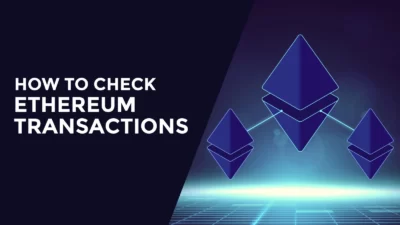Table of Contents
Toggle- What Is Ethereum Staking?
- How Much Ethereum is Needed for Staking?
- What Are the Risks Involved in Staking?
- Where to Go to Confirm Your Stake?
- Evaluating Staking Pool Providers
- Strategies for Maximizing Returns on Ethereum Staking
- How Much can you Earn Staking Ethereum?
- Where and How to Stake Ethereum?
- Conclusion
Are you looking for ways to make your investments pay off? Staking Ethereum might be the answer. In a nutshell, staking Ethereum involves locking up ETH coins in order to receive rewards.
When it comes to making wise decisions with your finances, there are a few things you need to consider. After all, where and how to stake Ethereum will make all the difference. Learn where and how to stake Ethereum, including the different staking options available and the best platforms to use for staking. This article will help you consider the risk, potential rewards, security protocols, and more. So let’s dive right into it and start understanding the intricacies of staking Ethereum!
What Is Ethereum Staking?
When it comes to Ethereum, there’s something new on the horizon known as staking. But what is it, exactly? Well, Ethereum staking is an increasingly popular way of earning interest and rewards on your crypto investments by locking them up in a savings account-like product.
With Ethereum staking, you are essentially making a commitment to hold onto your deposit for a specific amount of time. In exchange for this commitment to the network and its security, you receive rewards for doing so. You can think of it as putting your money in a CD (certificate of deposit) or into a savings account that offers an interest rate.
However, unlike traditional financial products where the interest rate is determined by the bank, the returns from staking vary depending on Ether’s market price fluctuations and network dynamics. This means that the rewards you receive when staking Ether can be much greater than those offered through traditional financial products. Additionally, it’s worth noting that with Ethereum staking, you still retain full ownership of your Ether while earning rewards in return, and that makes the whole process to buy Ethereum and stake it quite rewarding in itself!
How Much Ethereum is Needed for Staking?
Staking Ethereum requires the use of ETH, although you don’t need a huge amount to get started. Typically, the minimum is 32 ETH. If you have more than 32 ETH, then you’ll also be able to take advantage of higher rewards depending on the validator you choose.
It’s important to remember that staking Ethereum is a long-term commitment. When calculating how much ETH you need to stake, make sure that it’s not money that you expect to need in a short timeframe. Otherwise, you may run into some trouble when trying to access those funds again and could suffer penalties as a result of early withdrawal.
Also, keep in mind that there are additional costs associated with staking Ethereum, such as network fees and other costs from your validator. Make sure to factor these additional costs into your calculations when deciding how much Ethereum to stake and budget accordingly.
If you’re also looking to sell Bitcoin in Dubai, it’s important to navigate the local regulations and procedures. Selling Bitcoin involves finding suitable cryptocurrency exchanges or platforms. Dubai has been embracing cryptocurrencies, making it possible to sell Bitcoin in Dubai. Ensure you’re well-informed about the legal requirements and utilize reputable platforms to conduct your Bitcoin transactions successfully.
What Are the Risks Involved in Staking?
When you stake Ethereum, you’re essentially putting your tokens at risk in exchange for rewards. That’s why it’s important to understand the risks involved.
Locked Funds
When you stake your Ether, it will be locked up for the duration of the staking period — typically a few months — meaning that you won’t be able to access them during this time. This can certainly be inconvenient if you need access to those funds during the staking period.
Security Risks
Unfortunately, as with every cryptocurrency transaction, there is a risk of getting hacked. Before staking Ether, make sure you have secure storage and reliable software so that your funds are safe and sound.
Lock-up Periods and Penalization
Moststaking platforms have lock-up periods (the length of time before you can withdraw your tokens) that can range from one week up to six months or more. On top of that, some platforms may penalize users who try to withdraw their tokens early. Make sure to read all the terms and conditions on any platform before staking so you know what to expect.
Where to Go to Confirm Your Stake?
When it comes to confirming your Ethereum stake, you have multiple options. You can either go to a staking service provider or a cryptocurrency exchange.
Staking Service Providers
These services usually offer custodial solutions, meaning that the private key remains in their care and you don’t have control over it—but it does provide an extra layer of security for those who are new to staking Ethereum. Staking service providers will usually charge an annual fee for their services, which is normally around 2%.
Cryptocurrency exchanges
Many popular crypto exchanges offer a way to easily confirm your stake in Ethereum. This option can be more cost-effective since they don’t charge any annual fees, so if you already have an account on one of these exchanges this could be the right solution for you. However, your private key will remain with the exchange so you won’t have full control over your funds.
Evaluating Staking Pool Providers
When you’re deciding which staking pool provider to use, there are a few things to consider.
Fees and returns
First, each provider will charge a fee, so it’s important to compare the fees of multiple providers to get the best deal. As well as fees, keep an eye out for expected return rates, as some providers may offer higher returns than others.
Reputation and reliability
Next, check out the reputation of the various staking pool providers on offer. One way of doing that is by looking at reviews from other users—if there are lots of good ones, that’s a good sign. Also, look into how reliable they are—do they have a proven track record? These can all be indicators of how trustworthy they are.
Finally, make sure you’re aware of any additional services they may offer—for example, some providers include real-time tracking tools and notifications alerts so you can easily keep an eye on your stakes and rewards with ease.
By doing your research ahead of time, you can make sure that you find the right provider who will give you peace of mind when it comes to staking Ethereum securely and efficiently.
Strategies for Maximizing Returns on Ethereum Staking
When it comes to maximizing the returns on Ethereum staking, there are a few strategies you can employ.
Invest for the Long Term
Staking Ethereum is a great way to generate passive income, but the rewards you get may not be immediate. Depending on the platform you choose and the number of tokens you stake, it can take some time before you start to see your returns. That’s why it’s wise to invest for the long term—you’ll see higher returns this way since compounding and daily profits will start to add up over time.
Diversify Your Portfolio
Consider diversifying your staking portfolio by investing in different platforms or token pools. Doing so gives you better control over your investments as well as a better chance of earning more returns overall. For example, you could invest in higher-risk desktop wallet staking programs while also investing in lower-risk, custodial staking pools across multiple protocols and networks.
Research Your Options Carefully
Before investing in any Ethereum staking program, it’s important that you do your due diligence and research all of your options carefully. Make sure to read all terms and conditions carefully, look at past performance history if possible, and look at user reviews before putting any money into a program or pool. This will help ensure that you make wise decisions with your investments and maximize your potential returns from Ethereum staking.
How Much can you Earn Staking Ethereum?
How much can you earn from staking Ethereum? That depends on several factors, including the amount of Ethereum you stake, the length of time you stake, and the returns offered by the platform you use.
Generally speaking, if you stake a large amount of Ethereum for a longer period of time, you can expect higher rewards—and higher risk. That’s why it’s important to consider all your options carefully before taking the leap and staking your Ethereum.
How Much You Can Earn
Typically, users who stake Ethereum can earn anywhere from 5% to 10% per year on their investments. However, this depends on a number of factors, such as the specific platform you use and the number of Ethereum tokens (ETH) you’re staking in the first place. Let’s take a look at some specifics:
- The more ETH tokens you have to stake, the higher your rewards will be; this is especially true if you’re staking with an established platform that offers attractive return rates.
- If your ETH stake is kept for an extended period of time (e.g., one year or more), then potential returns could be higher as well.
- Some platforms offer bonus rewards for locking up ETH for even longer periods; these could potentially double or triple your earnings from staking ETH!
- Some platforms also offer additional benefits such as discounts on fees and access to special products or services; make sure to look into these too before making a decision about where to buy or sell Ethereum in Dubai or any other part of the globe and stake your Ethereum tokens.
Where and How to Stake Ethereum?
Staking Ethereum is a great way to maximize your returns on the platform. But where can you do this? You have two main options—stake on a validator pool or choose a staking provider.
Validator Pool
A validator pool is a platform that allows users to join forces in order to increase their chances of getting their stake included in the consensus blocks. The downside is, a user’s stake comes with an associated risk, as the malicious acts of any single user in the group can bring down the value of everyone else’s stakes.
Staking Provider
Staking provider platforms offer an easier way to stake your ETH by providing a custodial service that allows customers to “rent” ETH from them instead of purchasing it outright. Furthermore, staking providers use their own pool of capital to ensure maximum earnings and also provide additional services such as security audits and customer support.
So if you want a hassle-free staking experience with tons of features and added benefits like redundancy, then a staking provider is for you.
Conclusion
Whether you’re an experienced crypto-enthusiast or a complete novice, eth staking can be an excellent way to maximize your returns on the Ethereum you bring to the blockchain. Before you go ahead and stake your ether, it’s important to understand the risks involved and make sure you’re informed about the different staking strategies available to you. With careful consideration and the right information, staking can be a sound option for Ethereum users.
The great news is that staking your Ether doesn’t have to be a daunting task. With the right strategy and the right platform or service provider, you’ll be able to confidently stake Ethereum and make wise decisions about your investments.








